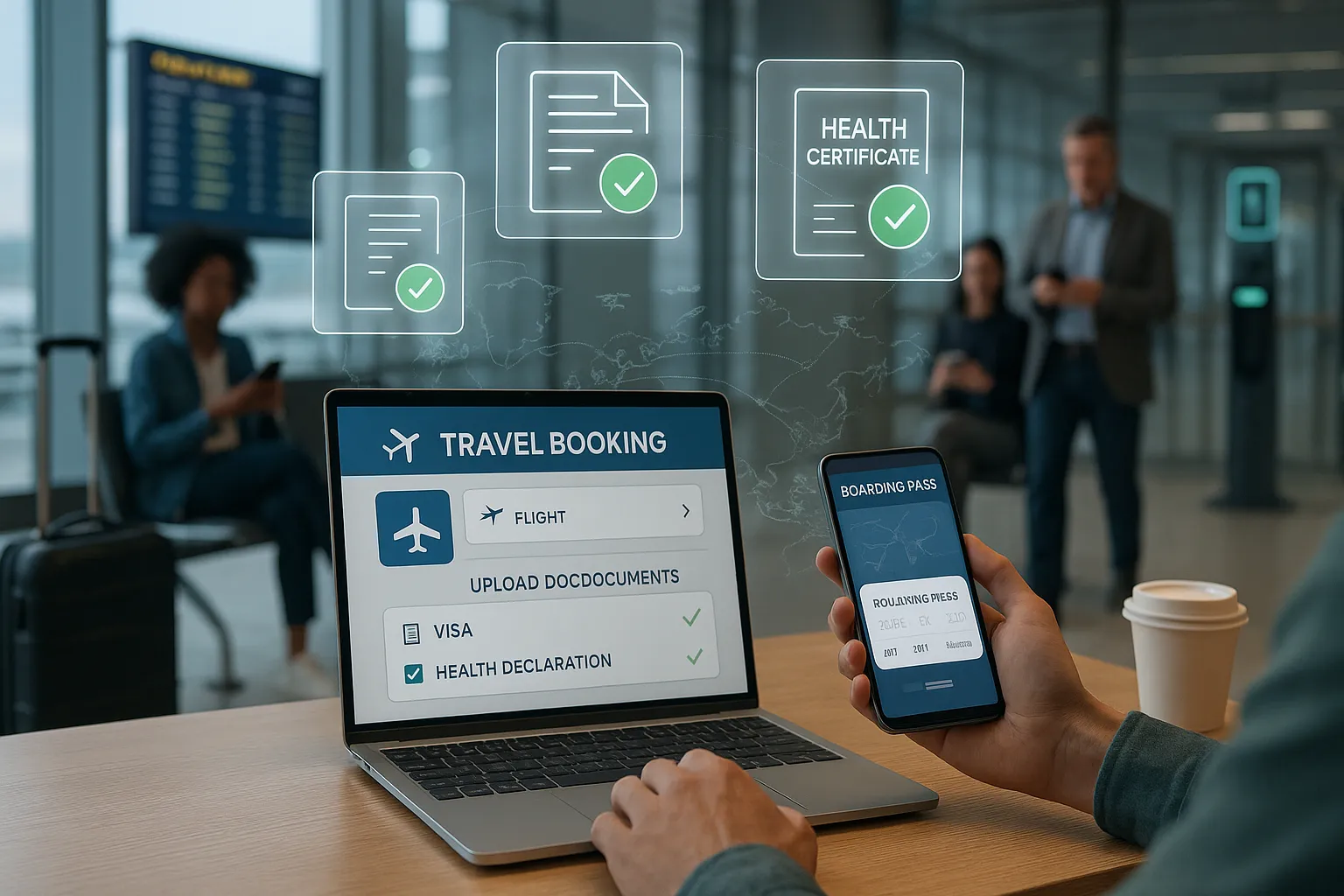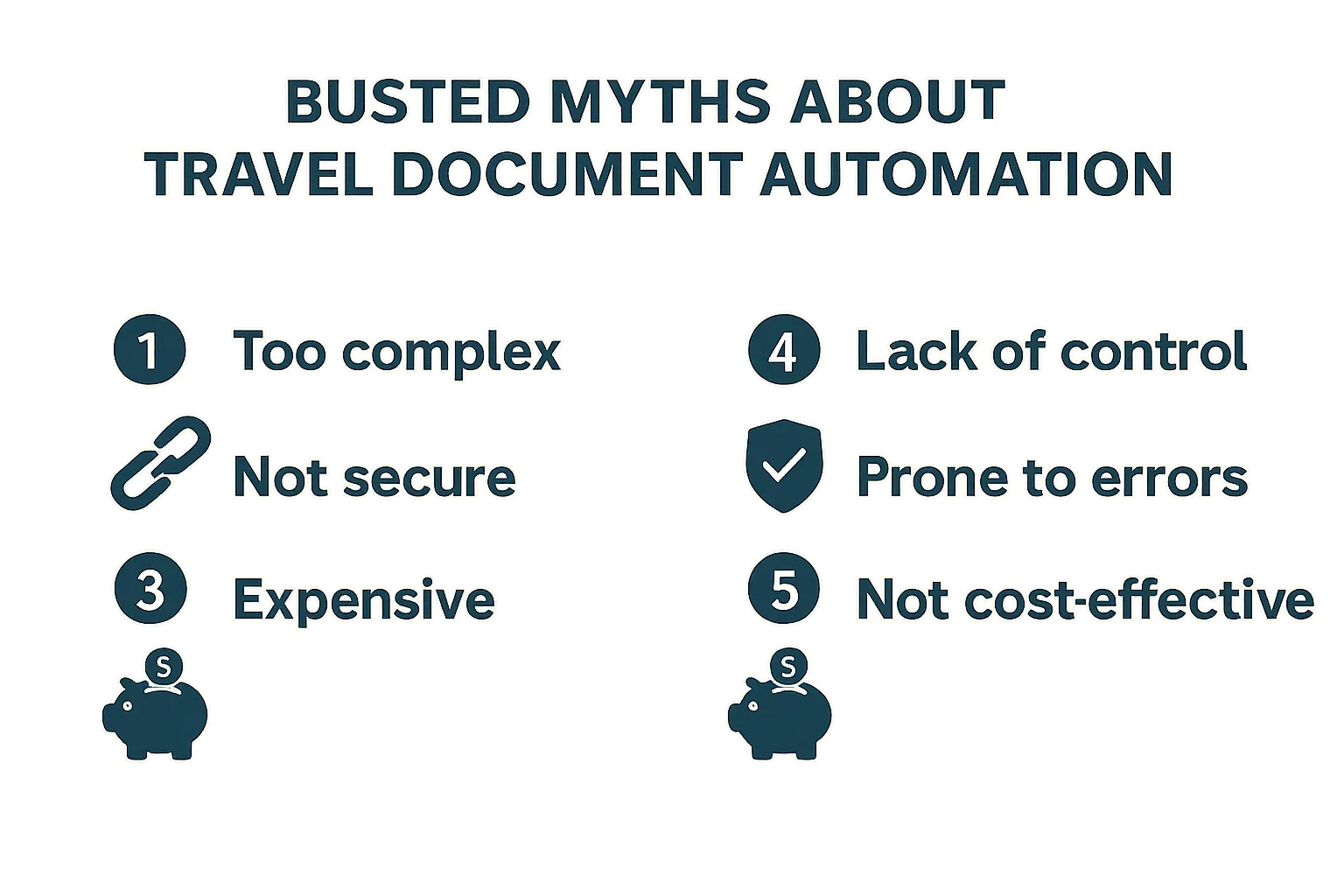What Is Travel Document Automation? Definitions, Benefits, and Myths

Digital check-in, paperless boarding passes, biometrics at security… modern travel is already automated in many places. Yet one crucial step often remains stuck in the last century: making sure every passenger holds the right documents to cross a border. From visas and eTAs to health declarations and transit permits, a single mistake can mean a denied boarding, a chargeback, or a furious online review.
That’s where Travel Document Automation (TDA) comes in. Below we unpack what the concept really means, how it works in practice, the value it creates for travel brands and travelers alike, and the myths that keep some companies from embracing it.
What exactly is Travel Document Automation?
Travel Document Automation is the end-to-end digital management of any document a traveler needs to cross an international border. Using a mix of real-time data, APIs, and workflow engines, a TDA platform can:
- Detect which documents are required for a specific origin–destination pair, passenger nationality, and trip purpose
- Guide the traveler through a compliant application flow (or automatically pre-populate an existing profile)
- Submit the application to the appropriate authority, pay the fees, and retrieve the approval
- Update the PNR or booking record with the confirmation so airline DCS, cruise lines, or tour operators can verify compliance instantly
In other words, instead of handing off travelers to an embassy website—or hoping they will “figure it out”—TDA brings the border requirements inside your booking flow.

Core building blocks
- Global rules engine – Continuously updated regulations covering 200+ jurisdictions, similar to IATA Timatic but built for API consumption.
- Application workflows – Dynamic forms that adapt to the passenger’s answers (passport type, vaccination status, travel history, etc.).
- Payment & submission gateway – Securely routes fees and documentation to the correct government endpoint (eVisa portal, eTA, ETIAS, ESTA, etc.).
- Status tracking & alerts – Pushes updates to both the traveler and the merchant (approved, pending, additional docs needed, expiration).
- Reporting & analytics – Provides compliance dashboards and revenue attribution for finance and ops teams.
Delivery models
- Embedded API – Integrate directly in your website, app, or GDS workflow.
- White-label web/app – Fast to deploy, zero-code option branded with your logo.
- Back-office agent portal – For call centers and brick-and-mortar agencies.
SimpleVisa supports all three, making it possible for a startup OTA or a global airline to roll out TDA in weeks, not years.
Five business benefits you can measure
-
Higher conversion & lower cart abandonment
34 % of travelers abandon a purchase when visa rules look complicated (Phocuswright, 2024). Offering one-click compliance keeps them in your funnel. -
New ancillary revenue
Through a service fee or revenue-share model, OTAs and airlines typically earn $8–$25 per passenger when they add visa processing at checkout—without lifting a finger in manual operations. -
Fewer boarding denials & chargebacks
Automated document checks upstream mean fewer last-minute surprises at the gate and less O&D disruption costs. -
Lean customer-support teams
TDA platforms like SimpleVisa answer the “Do I need a visa for X?” question instantly, slashing email and call volume by up to 40 %. -
Actionable compliance data
Track approval rates, processing time, and government fee pass-through per corridor—insights traditional manual checks can’t deliver.
Learn how a European low-cost carrier cut visa-related denied boardings by 72 % in six months using SimpleVisa’s API → Case study
Benefits for travelers (and why they’ll love you for it)
- Zero guesswork – Clear, interactive guidance backed by the same regulatory sources used at the border.
- Single checkout – Pay once for flights, bags, seat selection, and visa—all on the same screen.
- Real-time status – Push notifications when the document is approved or about to expire.
- Peace of mind – No more midnight searches on Reddit or last-minute embassy trips.
Want to see the traveler flow in action? Check our walkthrough of the upcoming ETIAS application process.
Six persistent myths about Travel Document Automation
Myth 1 – “Only mega-airlines can afford that technology.”
Reality: Modern visa APIs are cloud-native and priced per transaction. A niche safari operator can go live with the same tech stack used by a flag carrier—with no upfront capex.
Myth 2 – “Implementation will hijack our roadmap.”
Reality: With a no-code widget you can embed TDA in <15 minutes. Deeper PNR or API integrations typically take 2–3 sprints.
Myth 3 – “Automation equals security risks.”
Reality: SOC 2-compliant platforms use bank-grade encryption, tokenized payments, and zero-retention policies for passport images. For a deep dive, see How secure is the e-Visa system?.
Myth 4 – “We’ll lose control of our customer experience.”
Reality: White-label flows match your brand guidelines—fonts, colors, tone—so passengers feel they never left your site.
Myth 5 – “This will be obsolete once ETIAS/visa waivers roll out.”
Reality: Waiver programs increase pre-travel authorizations (think ESTA in the U.S.). ETIAS alone will add 45 million annual applications starting in 2025.
Myth 6 – “Government websites are good enough.”
Reality: Many official portals remain mobile-unfriendly, single-language, and don’t accept foreign cards—pain points that drive travelers to abandon or seek help elsewhere.

Choosing a Travel Document Automation partner: checklist
- Up-to-date rules for visas, transit permits, health forms, ETAs, and upcoming ETIAS
- Coverage across 95 % of global routes & nationalities
- API response times <300 ms (crucial for checkout UX)
- Multi-channel UI kit (web, native app, kiosk, call-center)
- Clear revenue-share or fee-per-file model, no hidden costs
- Compliance certifications (SOC 2, ISO 27001, PCI-DSS)
- Human support 24/7 for edge cases and escalations
SimpleVisa ticks all these boxes and is already embedded on 400+ travel sites worldwide.
Getting started in three steps
- Map the touchpoints – Identify where travelers currently drop off because of unclear visa info (search results, itinerary page, confirmation email, post-booking).
- Pick an integration mode – Widget for speed, API for deep control, or a hybrid approach.
- Run a controlled A/B test – Add TDA to 10 % of traffic and measure conversion uplift and ancillary revenue.
Most partners see positive ROI within the first quarter.
The bottom line
Travel Document Automation turns a stressful “paperwork chore” into a seamless value-add that benefits everyone involved:
- Travelers enjoy frictionless journeys.
- Travel brands monetize a pain point while reducing operational headaches.
- Border agencies receive cleaner, more accurate data.
With ETIAS, digital health certificates, and evolving visa policies on the horizon, automation is no longer a nice-to-have—it’s table stakes.
Ready to see what it could deliver for your business? Request a live demo of SimpleVisa and start turning compliance into conversion today.